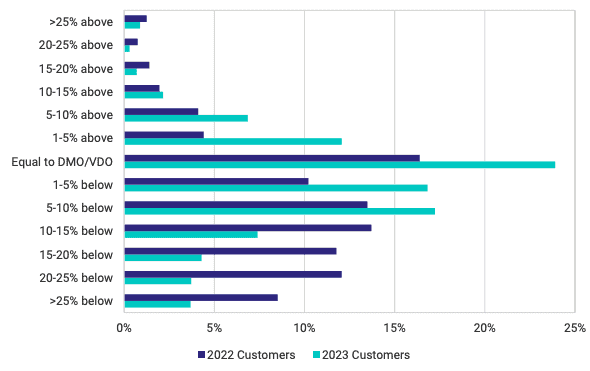For the first time, Australia’s consumer watchdog, the ACCC has used their compulsory information-gathering powers to obtain commercially sensitive data from energy providers about what they charge their existing customers.
The press release from December 2023 opens with “Competition in retailer electricity market is not delivering for all customers”. However, it’s fairer to say that most customers aren’t getting the benefits of competition.Existing customers pay too much.
The consumer watchdog collected the prices of flat rate market offers for over 5 million residential customers in NSW, Victoria, SE Qld and SA. This represents almost 60% of households and included solar owners. They discovered that 47% of customers were on plans with a calculated annual cost equal to or higher than the Default Offer. So, nearly one in two households pays the same or more than the safety net price. The regulated offer is designed to assist households unwilling or unable to select a market offer. Clearly competition isn’t working well if every second household is paying the equivalent of the Default Offer.
Shop it or cop it.
The watchdog found that consumers who don’t regularly shop around for a competitive deal experience higher prices. ACCC Commissioner Anna Brakey said. “Electricity retailers offer cheaper plans to attract new customers. Over time we observe these plans becoming relatively more expensive, so many loyal customers will be paying more than they need to be. Prices for new customers tend to be competitive, but we are concerned that the market is not delivering for customers who do not regularly switch or engage with their existing retailer.”
Four in five households could switch to a cheaper deal.
Digging deeper, the ACCC found that 79% of existing households paid more for electricity than the median market offer for new customers. Australia’s market regulator recognised that these customers could save money by switching to a cheaper deal.
Less people now on good deals.
The ACCC analysis of retailers data showed that the number of customers on deals that offered a savings of more than 10% off the DMO/VDO price has halved since 2022. In 2022 more than two out of five household were on a deal more with prices more than 10% cheaper than the default offer. However by August 23 only one in five customers were paying a prices that was 10% below the reference price or better.
Proportion of households on flat rate plans paying more, equal to or less than the DMO/VDO

Solar owners not immune
In August 2023, there were more than 3 million households and businesses with rooftop solar systems. The story is better for solar owners, simply because they buy a lot less energy. However, the ACCC was quick to point out that solar households aren’t immune from high grid prices.
Retailers offering solar plans with higher-than-average solar feed-in tariff rates came with higher underlying supply and usage charges. As acquisition offers, these plans are typically priced at or just below the default offer. Consumers with larger solar systems, low grid consumption and high export volumes may benefit from paying slightly higher prices if they receive a larger solar feed-in tariff. However, an analysis by the ACCC of the range of solar feed-in tariffs associated with existing customers’ plans found that for most customers, better-priced offers are available, even accounting for the size of the solar feed-in tariff.
In short, for solar owners, the Report demonstrated that higher solar feed-in tariffs are also available on plans with a calculated annual cost below the default offers – so it’s worth comparing.
Power shifting to better deal
The magnitude of price rises from July to August 2023 received a lot of media attention. For a period, there were limited options. However, since September, there has been a steady increase in the number of retailers offering lower-price plans. The issue is that most retailers are continuing to offer their best prices to new customers, while their existing customers are continuing to pay higher rates.
Switch or Speak up to save
No one is coming to save existing customers’ money. These households must switch or speak up to pay less for energy. Consumers can always ask their retailer whether they would be better off on another plan. We’d recommend understanding the best plan their retailer offers new customers. Or they may find a significantly better offer, and decide it’s high time for change. In any case, a comprehensive comparison is the best way to get informed and to find the best deal.

